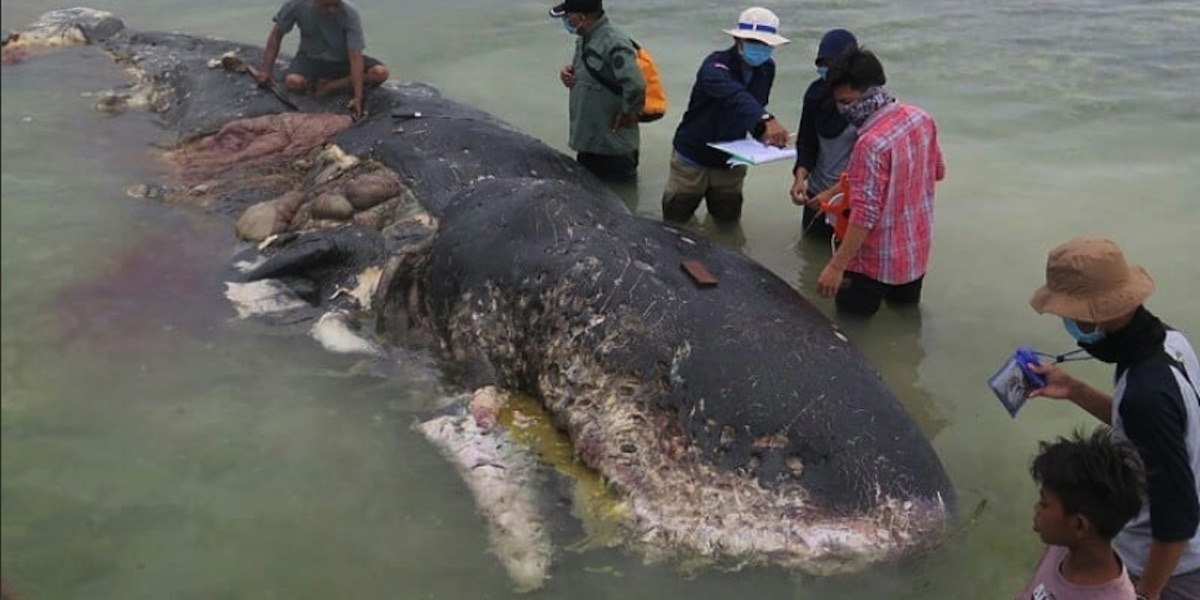

A sperm whale that washed up in Indonesia's Wakatobi National Park had plastic bottles, bags and cups in its belly. @WWF_ID / Kartika Sumolang
Yet another
whale has suffered from plastic pollution. A sperm whale that washed up dead in a national park in Indonesia had nearly 13 pounds of plastic waste in its stomach, park officials told the Associated Press.
Researchers from the
World Wildlife Fund (WWF) and the park’s conservation academy uncovered more than 1,000 other pieces of plastic, including 115 plastic cups, four plastic bottles, 25 plastic bags, 2 flip-flops and a nylon sack.
WWF-Indonesia posted
disturbing photos of the beached whale on social media.
The carcass of the 31-foot marine mammal—found late Monday near Kapota Island in Wakatobi National Park—contained “hard plastic (19 pieces, 140g), plastic bottles (4 pieces, 150g), plastic bags (25 pieces, 260g), flip-flops (2 pieces, 270g), pieces of string (3.26kg) & plastic cups (115 pieces, 750g),” the conservation group tweeted.
5,9 kg sampah plastik ditemukan di dlm perut paus malang ini! Sampah plastik yaitu: plastik keras (19 pcs, 140 gr), botol plastik (4 pcs, 150 gr), kantong plastik (25 pcs, 260 gr), sandal jepit (2 pcs, 270 gr), didominasi o/ tali rafia (3,26 kg) & gelas plastik (115 pcs, 750 gr). pic.twitter.com/ZFWZgkbnzu
— Yayasan WWF Indonesia (@WWF_ID) November 19, 2018
It’s not clear if plastic was the direct cause of the whale’s death since it was in an advanced state of decay when it was found, Dwi Suprapti, a marine species conservation co-ordinator at WWF-Indonesia, explained to the Associated Press.
“Although we have not been able to deduce the cause of death, the facts that we see are truly awful,” she said.
Wakatobi park plans to bury the whale on Tuesday and its remains will be used for study by the local marine academy,
Reuters reported.
Plastic pollution is a worldwide problem, but it’s
particularly bad in Asia, where there are few collection and recovery systems. China, Indonesia, the Philippines, Vietnam and Sri Lanka are responsible for up to 60 percent of the marine plastic entering our oceans, according to a 2015 study from the Ocean Conservancy and McKinsey Center for Business and Environment.
Around the world, an estimated
8 million metric tons of plastic waste gets dumped in our seas every year, causing countless marine animals to suffer from either becoming entangled in the material or ingesting it, which leads to suffocation or starvation. In June, a pilot whale died in southern Thailand after swallowing 17 pounds of plastics.
Indonesia itself produces about 130,000 tons of plastic and solid waste per day, The Guardian reported in March, citing data from the Rivers, Oceans, Lakes and Ecology Foundation. Unfortunately, only half of that trash reaches landfills. The remaining half is either illegally burned or dumped into the country’s waters.
Last year, the Indonesian government announced it will
pledge $1 billion a year toward reducing marine waste by 70 percent by 2025.
Luhut Binsar Pandjaitan, Indonesia’s coordinating minister of maritime affairs, told the AP that the whale’s plight should raise public awareness about the necessity to curb the use of plastic.
“I’m so sad to hear this,” said Pandjaitan. “It is possible that many other marine animals are also contaminated with plastic waste and this is very dangerous for our lives.”
Pandjaitan has pushed the government to take tougher action on plastic to help protect our oceans.
“This big ambition can be achieved if people learn to understand that plastic waste is a common enemy,” he said.
'Plastic, Plastic, So Much Plastic!': Diver Films Sea of Trash Off Bali https://t.co/0ekauIZKxu @PlasticPollutes @Oceana @WWF @YEARSofLIVING
— EcoWatch (@EcoWatch) March 6, 2018

 233k
233k  41k
41k  Subscribe
Subscribe 